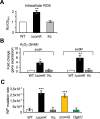The induction of natural competence adapts staphylococcal metabolism to infection
- PMID: 35314690
- PMCID: PMC8938553
- DOI: 10.1038/s41467-022-29206-7
The induction of natural competence adapts staphylococcal metabolism to infection
Abstract
A central question concerning natural competence is why orthologs of competence genes are conserved in non-competent bacterial species, suggesting they have a role other than in transformation. Here we show that competence induction in the human pathogen Staphylococcus aureus occurs in response to ROS and host defenses that compromise bacterial respiration during infection. Bacteria cope with reduced respiration by obtaining energy through fermentation instead. Since fermentation is energetically less efficient than respiration, the energy supply must be assured by increasing the glycolytic flux. The induction of natural competence increases the rate of glycolysis in bacteria that are unable to respire via upregulation of DNA- and glucose-uptake systems. A competent-defective mutant showed no such increase in glycolysis, which negatively affects its survival in both mouse and Galleria infection models. Natural competence foster genetic variability and provides S. aureus with additional nutritional and metabolic possibilities, allowing it to proliferate during infection.
© 2022. The Author(s).
Conflict of interest statement
The authors declare no competing interests.
Figures









Similar articles
-
Disruption of Glycolysis by Nutritional Immunity Activates a Two-Component System That Coordinates a Metabolic and Antihost Response by Staphylococcus aureus.mBio. 2019 Aug 6;10(4):e01321-19. doi: 10.1128/mBio.01321-19. mBio. 2019. PMID: 31387906 Free PMC article.
-
Expanded Glucose Import Capability Affords Staphylococcus aureus Optimized Glycolytic Flux during Infection.mBio. 2016 Jun 21;7(3):e00296-16. doi: 10.1128/mBio.00296-16. mBio. 2016. PMID: 27329749 Free PMC article.
-
Glycolytic dependency of high-level nitric oxide resistance and virulence in Staphylococcus aureus.mBio. 2015 Apr 7;6(2):e00045-15. doi: 10.1128/mBio.00045-15. mBio. 2015. PMID: 25852157 Free PMC article.
-
Staphylococcus aureus--probing for host weakness?J Bacteriol. 2008 Apr;190(7):2253-6. doi: 10.1128/JB.00043-08. Epub 2008 Jan 25. J Bacteriol. 2008. PMID: 18223088 Free PMC article. Review. No abstract available.
-
Metabolic control of virulence factor production in Staphylococcus aureus.Curr Opin Microbiol. 2020 Jun;55:81-87. doi: 10.1016/j.mib.2020.03.004. Epub 2020 May 7. Curr Opin Microbiol. 2020. PMID: 32388086 Free PMC article. Review.
Cited by
-
Calprotectin-mediated survival of Staphylococcus aureus in coculture with Pseudomonas aeruginosa occurs without nutrient metal sequestration.mBio. 2025 May 14;16(5):e0384624. doi: 10.1128/mbio.03846-24. Epub 2025 Mar 28. mBio. 2025. PMID: 40152583 Free PMC article.
-
Flotillin-mediated stabilization of unfolded proteins in bacterial membrane microdomains.Nat Commun. 2024 Jul 3;15(1):5583. doi: 10.1038/s41467-024-49951-1. Nat Commun. 2024. PMID: 38961085 Free PMC article.
-
Insight into the environmental cues modulating the expression of bacterial toxin-antitoxin systems.FEMS Microbiol Rev. 2025 Jan 14;49:fuaf007. doi: 10.1093/femsre/fuaf007. FEMS Microbiol Rev. 2025. PMID: 40052347 Free PMC article. Review.
-
Metabolic Rewiring of Bacterial Pathogens in Response to Antibiotic Pressure-A Molecular Perspective.Int J Mol Sci. 2025 Jun 11;26(12):5574. doi: 10.3390/ijms26125574. Int J Mol Sci. 2025. PMID: 40565037 Free PMC article. Review.
-
Type IV Pilus-Mediated Inhibition of Acinetobacter baumannii Biofilm Formation by Phenothiazine Compounds.Microbiol Spectr. 2023 Aug 17;11(4):e0102323. doi: 10.1128/spectrum.01023-23. Epub 2023 Jun 21. Microbiol Spectr. 2023. PMID: 37341603 Free PMC article.
References
-
- Lee AS, et al. Methicillin-resistant Staphylococcus aureus. Nat. Rev. Dis. Prim. 2018;4:18033. - PubMed
Publication types
MeSH terms
Substances
LinkOut - more resources
Full Text Sources
Medical
Molecular Biology Databases

